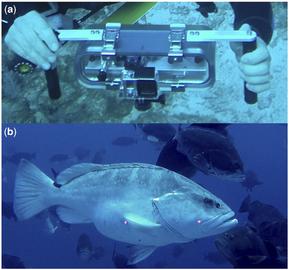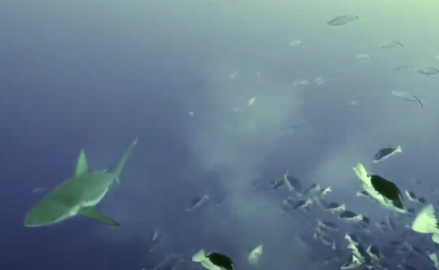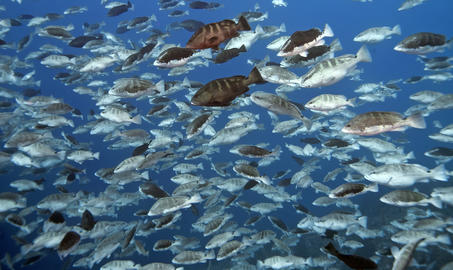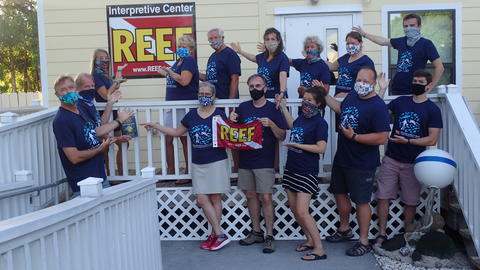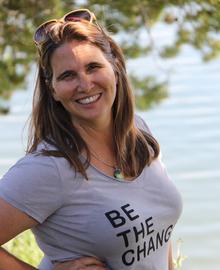New findings from the Grouper Moon Project reveal how technology can advance our understanding of changes in fish spawning aggregations due to conservation actions. The paper, published this year in ICES Journal of Marine Science, presents size data collected over a 17-year period at the Nassau Grouper spawning aggregation on Little Cayman. Fish usually need to be caught to be measured, but scientists from the Grouper Moon Project have used video camera systems to collect an impressive dataset on Nassau Grouper lengths.
Since last week, our partners at the Cayman Islands Department of Environment have been busy in the field, conducting multiple dives each day on the Nassau Grouper spawning site on the west end of Little Cayman. Since 2002, this site has been the focus of our collaborative conservation effort, the Grouper Moon Project. The team has been performing visual assessments, collecting size estimates through stereo-video, and capturing images of individual fishes for our "Fish Faces" project, which uses artificial intelligence to measure population size.
This study published by Friends of MacArthur Beach State Park supports previous research suggesting that participation in citizen-science programs can significantly enhance student learning and attitudes about science, while simultaneously promoting environmental stewardship. Since 1995, MacArthur Beach has been participating in REEF's Volunteer Fish Survey Project. In 2012, MacArthur Beach incorporated the REEF surveys into the park’s summer camp curriculum to increase monitoring efforts while also using the program as an educational tool.
Each winter since 2002, REEF has sent a team of researchers and volunteers to Little Cayman for the Grouper Moon Project. This collaborative research effort between REEF and the Cayman Islands Department of the Environment (CIDOE) conducts groundbreaking research to study the Nassau Grouper spawning aggregations, to help ensure recovery of the populations of this iconic and Critically Endangered species.
Fish usually need to be caught to be measured, but scientists from the Grouper Moon Project and Cayman Islands government have used video camera systems to collect an impressive 17-year dataset of Nassau Grouper lengths from Little Cayman. We combined this with information on growth and abundance to produce a comprehensive assessment of Nassau Grouper on Little Cayman. We found that Nassau Grouper recovered on Little Cayman largely thanks to one strong year class from 2011 spawning, 4-8x average.
Many have wondered REEF's Volunteer Fish Survey Project (VFSP) fared during a year when the COVID-19 pandemic made it challenging for many REEF volunteers to get in the water. We are pleased to share some good news from 2020:
- On April 1, 2020, the VFSP database surpased a quarter-million surveys. This is a significant milestone, not only for REEF and our worldwide community of ocean stewards, but for citizen science and marine conservation as a whole!
With 15,000 tube feet and up to 24 arms, the magnificent Sunflower Sea Star (Pycnopodia helianthoides) is found from Baja Mexico to Alaska. Since 2013, this magnificent species has suffered a dramatic decline due to a wasting disease. Many fear that the species may be on the brink of extinction.
We are extremely proud and honored to announce that one of REEF’s Executive Directors, Dr. Christy Pattengill-Semmens, was recently named to the Women Divers Hall of Fame. Christy is a marine biologist whose work at REEF intersects ocean citizen science, education, and conservation. She first worked with REEF as an intern in 1993 and then joined the REEF staff in 1998. Christy oversees all aspects of REEF’s Volunteer Fish Survey Project, one of the longest-running and largest marine life sightings programs, engaging volunteer divers and snorkelers all over the world.
A new research paper containing exciting findings from the Grouper Moon Project was recently published in the journal Marine Ecology Progress Series. Much of the science done by the project's collaborative team is focused on better understanding Nassau Grouper populations in the Cayman Islands through studying their spawning aggregations. However, long-term acoustic tags (tracking pingers) also allow us to gather information on how these fish behave at their home reefs outside of the spawning season.

